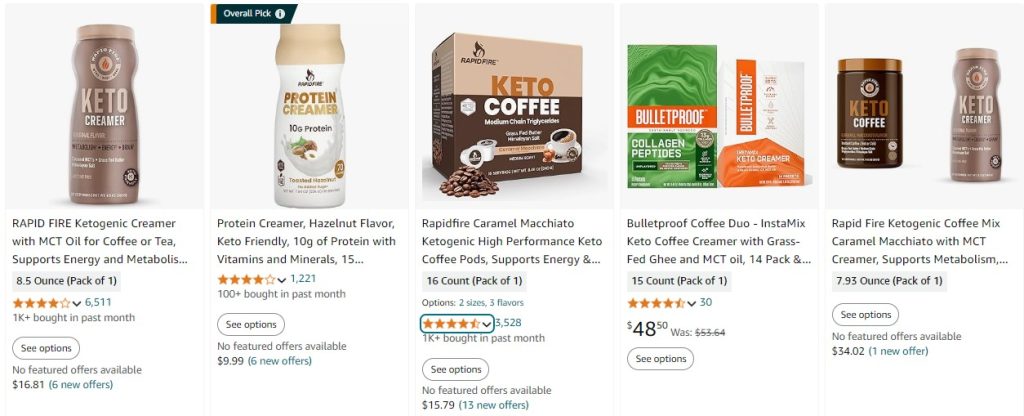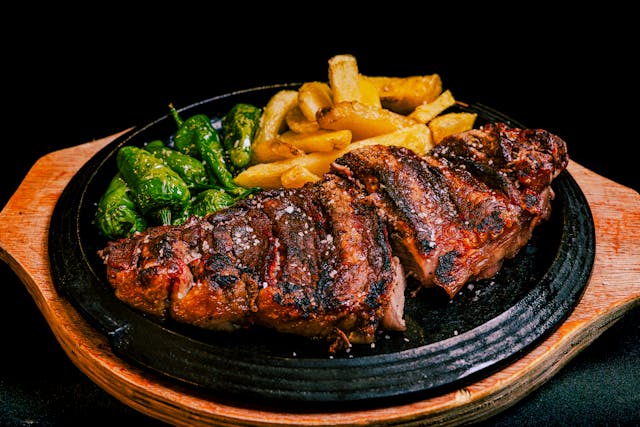Ah, beef jerky – that savory, chewy snack that’s been a favorite of hikers, road-trippers, and busy folks for ages. But here’s a question that might make you pause mid-chew: is beef jerky good for weight loss?
Let’s dive into this meaty topic and find out if this popular snack can be a part of your weight loss journey.
The Protein Powerhouse: Beef Jerky’s Nutritional Profile
First things first, let’s talk about what’s actually in beef jerky. This dried meat snack is primarily known for its high protein content.
And when it comes to weight loss, protein is often hailed as a superstar nutrient. Here’s why:
- Protein helps you feel full and satisfied, which can prevent overeating.
- It takes more energy for your body to digest protein, boosting your metabolism slightly.
- Protein helps preserve muscle mass during weight loss, which is crucial for maintaining a healthy metabolism.
A typical serving of beef jerky (about 1 ounce or 28 grams) contains around 9-14 grams of protein, depending on the brand and recipe. That’s a decent amount of protein in a small package!
Did you know, 58.9% of consumers reported that these supplements block up to 30% of dietary fat. Besides, 9,000+ positive Amazon reviews, confirm these as well.

Click here to browse Top Rated Weight Loss Supplements.
Delicious Beef Jerky Recipes for Weight Loss
Beef jerky is a great high-protein snack for weight loss because it’s low in fat and carbs while being rich in flavor.
Here are two detailed recipes: one for a classic, savory beef jerky and another with a spicy kick. Both are designed to be healthy and supportive of weight loss goals.
1. Classic Savory Beef Jerky
Ingredients:
- 2 lbs lean beef (top round, sirloin, or flank steak)
- 1/4 cup low-sodium soy sauce
- 2 tbsp Worcestershire sauce
- 1 tsp onion powder
- 1 tsp garlic powder
- 1/2 tsp black pepper
- 1/2 tsp smoked paprika
- 1/4 tsp ground cumin (optional)
- 1/4 tsp liquid smoke (optional, for extra smoky flavor)
- 1/2 tsp red pepper flakes (optional for mild heat)
Instructions:
- Prepare the Meat:
- Choose a lean cut of beef like top round or flank steak, which has less fat. Trim any visible fat from the beef to prevent the jerky from becoming greasy and to improve its shelf life.
- Freeze the meat for 1-2 hours. This will firm it up and make it easier to slice.
- Slice the beef into thin strips, about 1/8 to 1/4 inch thick, cutting against the grain for a more tender jerky, or with the grain for a chewier texture.
- Make the Marinade:
- In a large mixing bowl, combine the soy sauce, Worcestershire sauce, onion powder, garlic powder, black pepper, smoked paprika, cumin (if using), liquid smoke (if using), and red pepper flakes.
- Stir until all ingredients are well mixed.
- Marinate the Beef:
- Add the beef strips to the marinade, ensuring each piece is fully coated.
- Cover the bowl or transfer the beef and marinade to a large zip-top bag, removing as much air as possible.
- Refrigerate and let marinate for at least 4 hours, or preferably overnight, to allow the flavors to fully penetrate the meat.
- Dry the Beef:
- Preheat your oven to 170°F (or the lowest setting). If you have a dehydrator, set it to 160°F.
- Line a baking sheet with aluminum foil and place a wire rack on top.
- Arrange the marinated beef strips on the rack, making sure they do not overlap.
- If using the oven, keep the door slightly ajar to allow moisture to escape. Dry the beef for 4-6 hours, flipping the strips halfway through.
- The jerky is done when it is dry, but still slightly pliable (it shouldn’t snap in half easily).
- Cool and Store:
- Let the jerky cool completely before storing it in an airtight container. It will keep at room temperature for up to two weeks, or longer if refrigerated.
Nutritional Information (per 1 oz serving):
- Calories: 80-90
- Protein: 12-14g
- Fat: 1-2g
- Carbohydrates: 1-2g
2. Spicy Beef Jerky
Ingredients:
- 2 lbs lean beef (top round, sirloin, or flank steak)
- 1/4 cup low-sodium soy sauce
- 2 tbsp apple cider vinegar
- 2 tbsp sriracha or hot sauce of choice
- 1 tbsp honey or agave nectar (optional for a touch of sweetness)
- 1 tsp garlic powder
- 1 tsp onion powder
- 1 tsp smoked paprika
- 1/2 tsp ground cayenne pepper (adjust for desired heat level)
- 1/2 tsp black pepper
- 1/4 tsp crushed red pepper flakes (optional for extra heat)
Instructions:
- Prepare the Meat:
- Select a lean cut of beef and trim off all visible fat. Partially freeze the meat for 1-2 hours to make slicing easier.
- Slice the beef into thin strips, about 1/8 to 1/4 inch thick, cutting against the grain for a more tender jerky.
- Make the Marinade:
- In a large mixing bowl, combine soy sauce, apple cider vinegar, sriracha or hot sauce, honey (if using), garlic powder, onion powder, smoked paprika, cayenne pepper, black pepper, and red pepper flakes.
- Mix thoroughly until the marinade is well blended.
- Marinate the Beef:
- Add the beef strips to the marinade, ensuring each piece is well coated.
- Cover the bowl or place the beef and marinade in a large zip-top bag, removing as much air as possible.
- Marinate in the refrigerator for at least 4 hours, or preferably overnight.
- Dry the Beef:
- Preheat your oven to 170°F (or the lowest setting) or set your dehydrator to 160°F.
- Line a baking sheet with aluminum foil and place a wire rack on top.
- Arrange the beef strips on the rack, ensuring they do not overlap.
- Dry the beef in the oven (door slightly ajar) or dehydrator for 4-6 hours, flipping halfway through.
- The jerky is ready when it is dry but still slightly pliable.
- Cool and Store:
- Allow the jerky to cool completely before storing in an airtight container. It will keep at room temperature for up to two weeks or longer if stored in the refrigerator.
Nutritional Information (per 1 oz serving):
- Calories: 90-100
- Protein: 12-14g
- Fat: 1-2g
- Carbohydrates: 2-3g
Tips for Both Recipes:
- Portion Control: Measure out your servings to avoid overeating, as even healthy snacks can add up in calories.
- Storing Jerky: For long-term storage, you can freeze the jerky in vacuum-sealed bags.
- Low-Sodium Option: You can reduce the sodium content by using low-sodium soy sauce and reducing the marinade time.
These recipes are great for creating a high-protein, low-fat snack that can support your weight loss goals while satisfying your cravings.
Did you know 71.4% of consumers reported that coffee creamers boost their metabolism and aid in burning fat faster than ever! Also, don’t ignore 6,000+ Amazon ratings.

Click here to browse Top Rated Weight Loss Coffee Creamer.
The Calorie Conundrum: Is Beef Jerky a Low-Calorie Snack?
When you’re trying to lose weight, keeping an eye on calories is important. So how does beef jerky stack up?
Well, that same 1-ounce serving typically contains between 70-100 calories. Compared to many other snacks, this is relatively low-calorie, especially considering how filling it can be.
However, it’s worth noting that beef jerky is often quite salty, which can make it easy to overeat. And those calories can add up quickly if you’re not careful with portion sizes.
The Sodium Situation: A Potential Pitfall
Speaking of salt, this is where beef jerky faces its biggest challenge in the weight loss arena. Most commercial beef jerky is high in sodium, with that 1-ounce serving containing anywhere from 300-600 mg of sodium.
While sodium doesn’t directly cause weight gain, it can lead to water retention, which might show up on the scale and make you feel bloated. Plus, excessive sodium intake isn’t great for your overall health, especially if you have high blood pressure or heart issues.
The Sugar Surprise: Watch Out for Hidden Sweetness
Here’s something that might surprise you – some brands of beef jerky contain added sugars.
These sugars are often used in the curing process or added for flavor. While the amount is usually small, it’s something to be aware of if you’re closely monitoring your sugar intake for weight loss.
Always check the label, and opt for brands with little to no added sugar if possible.
Beef Jerky vs. Other Snacks: How Does It Compare?
Let’s put beef jerky in the ring with some other popular snacks:
- Potato chips: Higher in calories and fat, lower in protein
- Nuts: Similar in calories, higher in healthy fats, comparable protein
- Greek yogurt: Lower in calories, similar protein content, but perishable
- Protein bars: Often higher in calories and sugar, similar protein content
In this comparison, beef jerky holds its own as a convenient, high-protein, relatively low-calorie option.
Making Beef Jerky Work for Your Weight Loss Goals
So, can beef jerky be part of a weight loss diet? The answer is yes, with some caveats. Here are some tips to make beef jerky work for your weight loss goals:
- Watch your portions: Stick to the recommended serving size, typically around 1 ounce.
- Choose wisely: Look for brands with lower sodium and no added sugars.
- Balance it out: Pair your beef jerky with some fresh veggies or fruit to add fiber and nutrients.
- Timing is everything: Use beef jerky as a high-protein snack between meals to curb hunger.
- DIY option: Consider making your own beef jerky at home to control the ingredients.
Did you know, 72.2% of consumers reported they successfully lose weight by taking this pre-workout. Besides, you shouldn’t ignore 44,000+ positive Amazon ratings.
Click here to place your order!

The Bottom Line: A Protein-Packed Ally in Moderation
Is beef jerky good for weight loss? It can be, when consumed mindfully as part of a balanced diet. Its high protein content and convenience make it a potentially useful tool in your weight loss toolkit. However, its high sodium content means it shouldn’t be your go-to snack for every occasion.
Remember, no single food is a magic bullet for weight loss. The key to successful, sustainable weight loss is a well-rounded diet, regular physical activity, and lifestyle habits that you can maintain long-term.
So, if you enjoy beef jerky, there’s no need to ban it from your weight loss plan. Just be smart about your choices, keep an eye on those portions, and balance it with plenty of other nutritious foods. Happy snacking, and best of luck on your weight loss journey!
